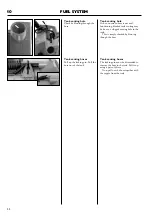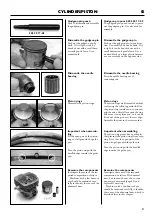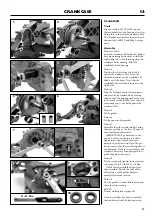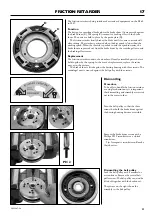
CRANKCASE
14
35
Leakage test
A leaking crankcase results in reduced crankcase compression. A typical sign is
that the machine is difficult to start.
Tools
Tools 502 71 39-01 and 506 34 45-01 are required during the leakage test to
seal the exhaust port and inlet port. Replace the decompression valve with
sealing plug 503 55 22-01.
Pressure tester 531 03 06-23, or the like, is needed for the test.
Important
Turn the crankshaft so that the inlet port is fully open, i.e. that the piston is
at its upper turning point.
The clutch lubrication channel
1. Tape over the clutch lubrication channel on the
crankshaft. Does not apply to machines with ball
bearing-mounted clutch drum.
Inlet duct
Dismantle the carburettor, see page 6.
2. Dismantle the partition wall in the inlet duct.
Inlet port
3. Assemble the sealing disc with screws, size
M4 x 20 mm with washers.
Exhaust port
4. Dismantle the cutting head and the muffler as
set out on page 5 and 7.
Assemble the sealing disc with the screws used for
the muffler.
Sealing plug
5. Fit the sealing plug 503 55 22-01 in the hole in
the cylinder for the decompression valve.
Test for leakage
Connect the pressure tester to the nipple on the inlet seal.
Pump a pressure to 50 kPa. After 30 seconds the pressure must not drop
below 20 kPa.
If a leakage is indicated
Note that the testing method also involves testing the inlet manifold and
its connections. First check that there is no leakage from here (leaking inlet
manifold or poorly tightened clamp around this).
Find the leakage by brushing with soapy water or use a leakage spray. First
check the sealing rings on the crankshaft. Next check by the gaskets (crankcase
halves, base of the cylinder). The third possibility is crack formation on the
crankcase.
531 03 06-23
3
1
4
2
5
506 34 45-01
502 71 39-01
503 55 22-01
M4 x 20 mm
















































